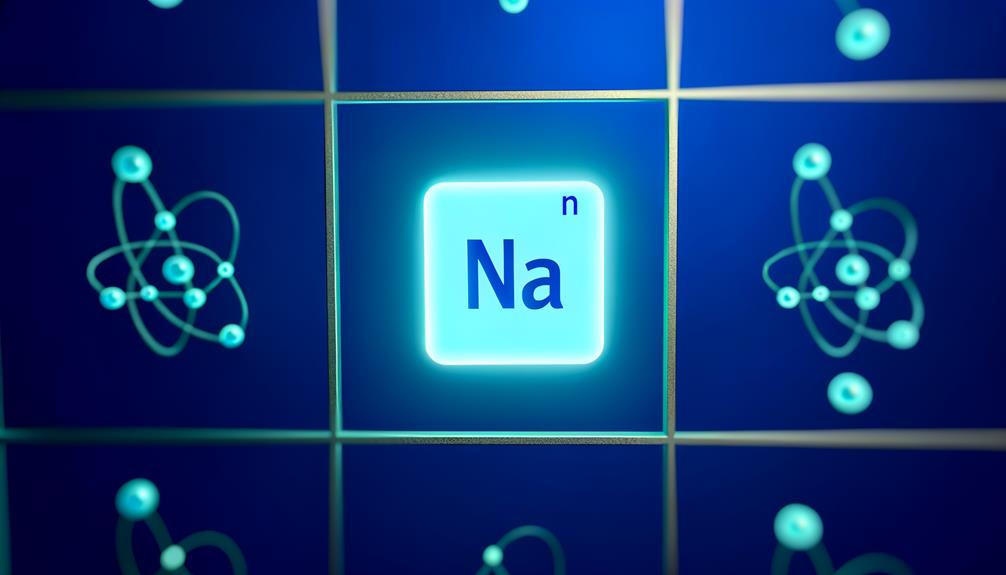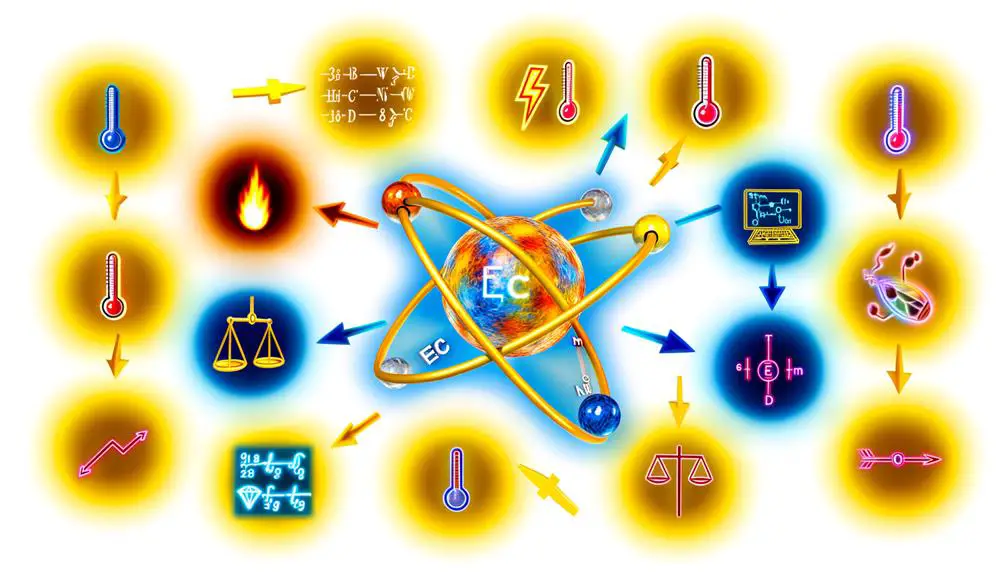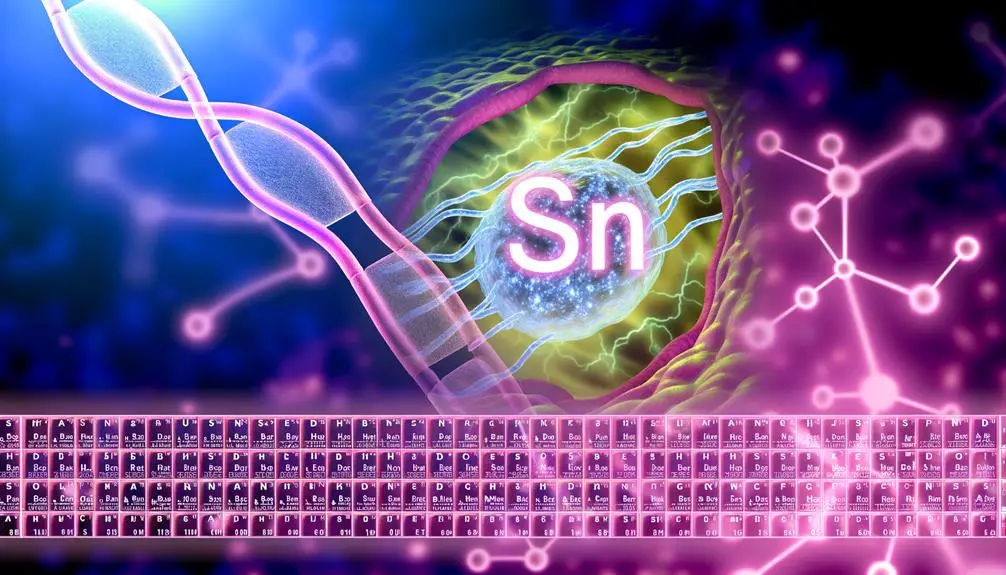Na Symbol Meaning on the Periodic Table
The symbol 'Na' on the periodic table denotes sodium, an alkali metal with the atomic number 11. The designation 'Na' stems from 'natrium,' the Latin name for sodium.
Sir Humphry Davy isolated sodium in 1807 by using the electrolysis of molten sodium hydroxide, marking a critical advancement in inorganic chemistry. Sodium belongs to Group 1 of the periodic table, characterized by high reactivity, especially with water, resulting in vigorous exothermic reactions.
Its essential roles span from industrial applications to biological importance in cellular function and fluid balance. Discover its diverse applications and properties further.

Key Takeaways
- The symbol 'Na' for sodium originates from its Latin name 'natrium'.
- Sodium, represented by 'Na', was isolated by Sir Humphry Davy in 1807.
- 'Na' denotes sodium, an alkali metal in Group 1 with atomic number 11.
- Sodium's reactivity is due to its single valence electron.
- 'Na' reflects sodium's historical and linguistic roots from Greek 'nítron' and Latin 'natrium'.
Historical Background

The symbol 'Na' for sodium on the periodic table originates from the Latin word 'natrium,' reflecting its historical association with natron, a natural mineral. Sodium, isolated in 1807 by Sir Humphry Davy, has played a significant role in scientific development.
Early civilizations used sodium compounds extensively, particularly in glass-making and food preservation. The term natron itself derives from the ancient Egyptian 'nṯr', denoting divine or pure substances, indicating sodium's prominent place in antiquity.
During the 18th and 19th centuries, scientific advancements necessitated a systematic approach to element nomenclature, leading to the adoption of 'Na' in the periodic table. This historical context underscores the evolution of chemical understanding and the practical applications of sodium throughout human history.
Latin Origins of Na
The symbol 'Na' for sodium originates from its Latin name, 'Natrium.'
This nomenclature underscores the historical influence of Latin on the modern periodic table, reflecting the element's early discovery and usage in ancient times.
Understanding these Latin roots provides valuable context for the etymology and classification conventions in chemistry.
Sodium's Latin Name
Derived from the Latin word 'Natrium,' the symbol 'Na' on the periodic table represents the element sodium. This nomenclature traces back to the Greek word 'nítron,' which referred to a natural mineral salt.
The choice of 'Na' for sodium underscores the historical linguistic influences on chemical element naming conventions. Natrium itself is derived from the Egyptian natron, a naturally occurring mixture of sodium carbonate decahydrate.
Sodium, a highly reactive alkali metal, was isolated by Sir Humphry Davy in 1807 using electrolysis of molten sodium hydroxide. Understanding the Latin origins of 'Na' provides insight into the historical context and etymological evolution of chemical symbols, reflecting the blend of scientific discovery and linguistic heritage.
Historical Latin Influence
Latin's deep impact on the scientific nomenclature is exemplified by the symbol 'Na' for sodium, highlighting the lasting legacy of classical languages in modern chemistry. Derived from the Latin word 'natrium,' the term references a naturally occurring compound, natron, which was historically significant in ancient cultures for its use in mummification and soap production.
The adoption of 'Na' underscores the systematic approach of early chemists who sought to standardize chemical symbols based on Latin roots. This practice not only facilitated international scientific communication but also preserved the etymological heritage of elemental names.
Therefore, the symbol 'Na' is a tribute to the historical integration of Latin in the lexicon of modern scientific discourse.
Discovery of Sodium

Sodium was first isolated by the English chemist Sir Humphry Davy in 1807 through the electrolysis of molten sodium hydroxide. Davy's pioneering work utilized an electrochemical method to decompose the compound, successfully extracting the metal.
This process involved passing an electric current through molten sodium hydroxide, leading to the liberation of sodium at the cathode and the release of oxygen at the anode. This discovery was significant as it demonstrated the feasibility of using electrolysis to isolate highly reactive alkali metals.
Davy's method leveraged advancements in voltaic cell technology, marking a pivotal moment in inorganic chemistry. The isolation of sodium not only broadened the understanding of elemental substances but also paved the way for further discoveries within the alkali metal group.
Sodium's Place in the Periodic Table
Sodium, denoted by the symbol Na and possessing an atomic number of 11, occupies a key position in Group 1 of the periodic table, known as the alkali metals.
Characterized by its high reactivity and propensity to form ionic compounds, sodium's chemical properties play a critical role in various industrial applications.
Additionally, sodium's biological significance is underscored by its essential function in maintaining cellular homeostasis and nerve impulse transmission.
Atomic Number and Symbol
Occupying position 11 on the periodic table, sodium is represented by the symbol 'Na', derived from its Latin name 'Natrium'. This alkali metal is situated in Group 1, indicating its single valence electron, which contributes to its high reactivity. Sodium's atomic number, 11, signifies that it has 11 protons in its nucleus and, in its neutral state, 11 electrons.
| Property | Value | Significance |
|---|---|---|
| Atomic Number | 11 | Defines the number of protons and electrons |
| Symbol | Na | Derived from the Latin name 'Natrium' |
| Group | 1 | Indicates it is an alkali metal |
Understanding sodium's placement provides insight into its fundamental properties and behavior in various chemical reactions.
Chemical Properties Overview
As an alkali metal, sodium exhibits highly reactive chemical properties due to its single valence electron, which is easily lost to form a positive ion. Positioned in Group 1 of the periodic table, sodium (Na) has an atomic number of 11.
The loss of its lone valence electron results in a stable, positively charged Na⁺ ion, vital in various compounds. Sodium reacts vigorously with water, producing sodium hydroxide and hydrogen gas, indicative of its high reactivity.
Its electropositive nature makes it a strong reducing agent, readily engaging in electron transfer reactions. In compounds, sodium often forms ionic bonds, contributing to the stability and formation of various essential salts and minerals.
Biological Importance Explained
Essential to numerous physiological processes, sodium ions play an important role in maintaining cellular homeostasis and facilitating nerve impulse transmission across membranes.
Sodium's unique properties allow it to regulate fluid balance, blood pressure, and osmotic equilibrium, making it indispensable for human health. It is involved in muscle contraction, nutrient absorption, and the proper function of the nervous system.
The precise regulation of sodium levels is critical, as imbalances can lead to severe health consequences.
- Vital for nerve signal transmission
- Essential in muscle function and contraction
- Crucial for maintaining blood pressure
- Involved in nutrient absorption and transport
- Regulates fluid balance and cellular hydration
Understanding sodium's biological importance highlights its critical place in the periodic table and in maintaining physiological health.
Physical Properties

Sodium (Na) displays several distinct physical properties, including a soft, silvery-white appearance and a relatively low melting point of 97.79°C. It is characterized by a body-centered cubic crystal structure and a density of approximately 0.97 g/cm³ at room temperature, making it less dense than water.
Sodium is highly malleable and can be easily cut with a knife. Its electrical conductivity is notable, as it efficiently transports electricity due to its single valence electron, which moves freely. Additionally, sodium's thermal conductivity is significant, facilitating rapid heat transfer.
These physical attributes make sodium an essential element in various industrial applications, including the manufacturing of sodium vapor lamps and as a coolant in certain nuclear reactors.
Chemical Properties
Demonstrating high reactivity, particularly with water, sodium readily forms compounds through oxidation and reduction reactions. This alkali metal's single valence electron facilitates its participation in various chemical processes, making it an essential element in numerous reactions.
Sodium's high reactivity with water results in the formation of sodium hydroxide and hydrogen gas, a highly exothermic reaction. Additionally, sodium reacts with halogens to form ionic salts and can also engage in redox reactions, altering its oxidation state.
- Vigorous reaction with water releasing hydrogen gas
- Formation of strong bases with hydroxides
- High exothermic properties in reactions
- Ability to form ionic compounds readily
- Significant role in redox reactions
Such properties underscore sodium's importance in both industrial and laboratory settings.
Common Uses of Sodium

Utilized extensively in industry and daily life, sodium's applications range from the production of glass and paper to its role in pharmaceuticals and food preservation.
In industrial processes, sodium compounds such as sodium carbonate (soda ash) and sodium hydroxide (caustic soda) are essential. Soda ash is indispensable in glass manufacturing, enhancing chemical stability and workability. Sodium hydroxide, a strong alkali, is fundamental in paper production, aiding in cellulose extraction and lignin removal.
In pharmaceuticals, sodium salts like sodium bicarbonate serve as antacids, while sodium chloride is vital for intravenous solutions. Additionally, sodium nitrate is used in food preservation, particularly in curing meats, to inhibit microbial growth and maintain product quality.
Each application underscores sodium's multifaceted utility.
Sodium in Everyday Life
Beyond industrial applications, sodium plays a significant role in everyday life through its presence in household products, culinary practices, and health-related uses.
Sodium chloride, commonly known as table salt, is essential for seasoning and preserving food.
Sodium bicarbonate, or baking soda, is a versatile cleaning agent and a key ingredient in baking.
Sodium hydroxide is found in drain cleaners and soap production.
Sodium hypochlorite serves as a potent disinfectant in household bleach.
These applications underscore the element's wide-reaching impact:
- Enhances flavors and preserves foods.
- Contributes to household cleaning efficacy.
- Supports safe and effective disinfection.
- Facilitates personal hygiene through soap production.
- Aids in versatile culinary baking processes.
Thus, sodium's ubiquitous presence underscores its critical importance in daily life.
Sodium's Biological Importance

Sodium plays an important role in maintaining cellular function and fluid balance within the human body. It is a critical electrolyte that facilitates nerve impulse transmission, muscle contraction, and regulation of blood pressure.
Sodium ions (Na⁺) are pivotal in the sodium-potassium pump mechanism, which actively transports sodium out of cells while bringing potassium in, maintaining cellular homeostasis. This electrochemical gradient is essential for various physiological processes, including nutrient absorption and waste excretion.
Additionally, sodium's osmotic properties help regulate extracellular fluid volume, ensuring optimal hydration and nutrient delivery. Imbalances in sodium levels can lead to conditions such as hyponatremia or hypernatremia, which can disrupt normal cellular activities and pose significant health risks.
Conclusion
In summation, sodium, denoted by the symbol Na from its Latin name 'Natrium,' is a fundamental element with significant historical, chemical, and biological relevance.
Its discovery and placement in the periodic table underscore its crucial role in numerous applications, ranging from industrial to biological systems.
Sodium's unique physical and chemical properties render it essential in various fields, epitomizing the intricate relationship between elemental properties and their practical utility—truly, a cornerstone of both chemistry and life sciences.






